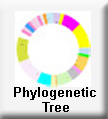Lobocriconema thornei
Knobloch & Bird, 1978
The undescribed species of the genus Lobocriconema, recovered commonly
and in high population densities from the original sampling of the experimental
site, was named Lobocriconema thornei in honor of Professor Gerald
Thorne. His guidance, encouragement, and friendship will never be
forgotten. The morphometrics and morphological descriptions of the
types are:
Holotype female: L = 0.50; a = 9.4;
b = 3.6; V = 90%; stylet 87 um; R (number of body annules) 46.
Paratype females: (20): L = 0.55 (0.48 -
0.64) mm; a = 9 (8 - 11); B = 3.8 (3.2 - 4.5); c = (from ventral view of
two paratype females) 37 - 38; V = 92% (90 - 92%); stylet = 89 (85 - 97)
um; R = 49 (46 - 51).
Body thick, cylindroid, tapering toward both blunt
extremities. Body straight or very slightly ventrally arcuate when
killed by gentle heat. Annules retrorse except two most-anterior;
posterior edges smooth. In a few paratype females, posterior edges
rough on ventral side near posterior end. Very faint ornamentation
of small lines, dots, or punctations on subcuticle underneath each annule.
Width of annules at mid-body about 10 um, no anastomoses.
Stylet well developed; basal part 22 um long; anterior part 67 um
long. Basal knobs about 12 um wide with pointed outer edges
directed anteriad. Submedian lobes and cephalic framework prominent.
Excretory pore opening in fifteenth annule from anterior end. Vulva
on fifth annule from terminal knob. Vagina sigmoid, narrow, leading
to a wide uterus; round spermatheca prominent, filled with sperm.
Ovary prodelphic, outstretched. In a few specimens, ovary is reflexed;
in some specimens, ovary extends to middle of stylet. Anus not observed
in holotype; in ventral views of paratype females, anus on first or second
annule from terminus. Tail conoid, bluntly rounded at end, with knob
at terminus.
Allotype male: L = 0.56 mm; a = 20;
c = 11; spicules = 47 um; gubernaculum = 8 um; T = 33.
Paratype males (2): L = 0.49 (0.48 - 0.50)
mm; a = 20 (19 - 21); c = 10 (10 - 11); spicules 45 (44 - 46) um;
gubernaculum 7.5 (7 - 8) um; T = 39 (38 - 41).
Body almost straight in anterior part; at middle
of body, shape becomes ventrally arcuate. Head flatly rounded.
Annulation coarse. Lateral field with four incisures. Excretory
pore opening on 30th body annule from anterior end. Hemizonid located
at third annule anterior to excretory pore. Testes single, occupying
most of body width. Spicules 47 um long, slender, curved cephalate
proximally, pointed distally. Anal sheath present. Gubernaculum
slightly curved, 8 um long. Tail curved ventrally, rounded
at terminus. Bursa
as illustrated.
Juvenile: 3rd stage: L = 0.32 mm; a = 11;
b = 3.3; stylet = 54 um; R = 53.
No juveniles of L. thornei were found for
several years. On April 26, 1976, several fourth-stage moults with
the adult female and male were collected at the original site. Later
a third moult was found and a third-stage nonmoulting juvenile. The fouth-stage
juvenile is 0.29 mm, with 51-52 body annules and stylet 65 um long.
Cuticular patterns
are as shown.
Diagnosis: Lobocriconema thornei
is
most similar to L. neoaxestum (Jairajpuri & A. H. Siddiqi, 1963)
de Grisse, 1967, L. crassianulatum (de Guiran, 1963) de Grisse &
Loof, 1965, and L. rara Boonduang, A. and R. Ratanaprapa, D., 1974.
L.
thornei differs from L. neoaxestum in shape of head region,
length of stylet, smooth body annules, position of vulva.
L. neoaxestum
has
a poorly differentiated neck annule, stylet 65-75
um long, body
annules marked with longitudinal striations and rough posterior margins,
vulva on seventh or eighth annule, and juveniles present. From L.
crassianulatum, L. thornei differs in its larger size, number
of body annules, stylet length, shape of head, and tail terminus. L.
crassianulatum has a body length of 236 - 362 um, 33 - 41 body
annules, stylet length 51 - 70 um; and although the neck annule
is well differentiated, all the body annules except the first are retrorse
and the tail terminus is ventrally contracted. From L. rara,
it differs in body length, vulval position, stylet length, and number of
body annules. L. rara has a body length of 0.375 (0.350 -
0.400) mm; V = 95.9 (94.3 - 97.5)%; stylet 54 (51 - 57) um; and
body annules 61 (56 - 65).
Type habitat and locality: Soil around
roots of maple trees, Acer saccharum, and numerous other habitats
in woods of the Michigan State University Water Quality Management Project
site in East Lansing, Michigan, U.S.A.
(Description- Knobloch & Bird, 1978)
This
species included in the Criconematid Project
DNA Sequences Obtained:
Specimen:
Collected:





